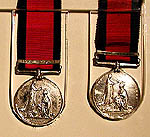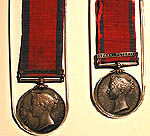Although they ran into stormy weather on Lake Erie, the relief forces arrived in Amherstburg on August 13. That night Brock met Tecumseh for the first time. Together, they came up with a plan to attack the Americans in Detroit.
The British troops had taken possession of the Americans' deserted camp on François Baby's farm. They erected two gun batteries, one hidden behind Baby's old house. On August 15, Brock sent a message to Hull, demanding his surrender. When Hull refused, the British guns started to bombard Fort Detroit.
In the early morning of August 16, Brock led a group of army, militia and Natives across the river. The British ships Queen Charlotte and General Hunter had sailed up from Lake Erie and they protected the men crossing. The British landed at Spring Wells, about 3 miles south of Detroit. They marched towards Detroit. Brock had dressed the militia in cast-off red coats from the army, so that the Americans would think that they had more trained soldiers than they did. When he had his men form into lines, Brock was hoping to push the Americans into coming out of the fort to do battle with him. Instead, to everyone's surprise, General Hull decided to surrender. Hull was afraid for the American civilians, especially his own family, and he thought that the Natives would massacre them.

Francois Baby's farm
Francois Baby's farm


